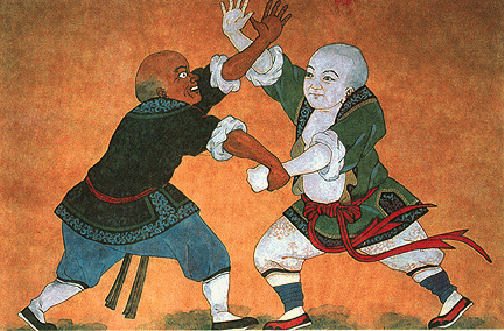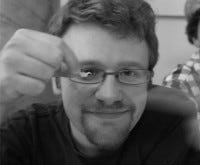Pac-Man Championship Edition design analysis (Jonathan Blow lecture transcript)
In 2007 at the Montreal Design Reboot, Jonathan Blow gave a lecture about game design. It became famous for blasting the design of MMORPGs. But there were many more insights in the lecture - this section looks at "listening skills" used in Pac-Man CE.

In 2007 at the Montreal Design Reboot, Jonathan Blow gave a lecture about game design. The lecture would become infamous for a passage about World of Warcraft that was actually animated by the Superbrothers.
But in my opinion, of the many disconnected yet very powerful insights given in this lecture, the part about World of Warcraft isn't even in the top three. In this post I'll be transcribing and illustrating an excellent piece of design criticism concerning Pac-Man: Championship Edition. To clarify though: this is not a direct transcript and many of the words are mine.
The confident architect
As designers we often want to impose our will upon a game engine, to build up some specific choice or theme that we consider interesting. We might obsess over the coolness of this one feature and make big plans for its visual presentation and how it is developed by the story. We might actually do all this and feel we have it all planned out before we even start programming it into the engine or seeing what effect it has on other mechanics.

Examples would include the rewind mechanic in Prince of Persia: Sands of Time, or the Little Sister choice in Bioshock, or the suicide mechanics in Voodoo Vince - these are rather isolated gameplay elements that are imposed upon the game engine by designers confident about their coolness. They can often be somewhat interesting; but they may fail to play into the game's broader system in any sophisticated way.
Good game designers need "listening skills"
This is an idea from the martial arts. There it refers not to listening with your ears, but with your body.

Sparring
So: if you're fighting somebody, and they punch you and you block them - what are you going to do? You could fight back... you could pull their arm down! And punch them in the head! - you could do that, but it takes a lot of energy and has a high probability of failure. And there are other things you can do; since you've got a point of contact, you don't have to watch them doing something, you can feel what they're about to do. Then you can react in a way that better takes advantage of the situation, and is harmonious with what they want to do, and with what you want to do. We can apply this kind of idea in game design...

But it is hard to listen if you're shouting all the time. If your design is always about enforcing some idea from the top down, and hammering the code into doing what you want to do, then you blind yourself to the possibilities that are being revealed.
Pac-Man

In the original Pac-Man, you have these ghotsts that are chasing you and trying to kill you. But you can eat a power pill, which will cause the ghosts to turn blue and run away, and you can chase them and eat them for some points. This is a rather profound central gimmick: the hunters becoming the hunted.
You're safe for the limited duration of the Power Pill's effect. How long does that effect last? It's a specific amount of time but there is no number counting down. Instead, when the ghosts are about to start harming you again, they'll flash blue-to-white-to-blue-to-white, and then they start coming after you.
The mechanics described here give rise to a rather interesting possibility. If you were to eat all four of the ghosts, then you no longer have an indicator of when the power pill's effects will wear off. In the original Pac-Man, that didn't really matter...
Pac-Man Championship Edition

... but in Pac-Man Championship Edition, the indicator is very important, because when you eat chains of power pills and get more than four ghosts in a row, you drive up the bonus multiplier. If you eat a new pill while still under the effects of another pill, you renew the pill timer. And you also want to eat as many ghosts as you possibly can, so you aim to eat successive pills at the very last moment before the previous pill expires...
It is an interesting tradeoff, on its own, whether to risk trying to eat another ghost before going for the next pill you need. But on top of this, we have this wonderful interaction that comes from that scenario from the original Pac-Man.
You want to effectively know when the pill you're on is about to expire, but if you eat all the ghosts, you lose the indicator of when that is. And you do want to eat all the ghosts, because that'll give you a better score and increase your multiplier. Either way you make this choice will have both positive and negative implications for you both over the short term and the long term.
It is remarkable how this subtle interaction was improved upon from the original game to the sequel. And it is not the only one. In the original Pac-Man, after you eat a ghost, its eyeballs are transported to the middle of the level, where the ghost will be revived - but the transportation of the eyeballs is not instantaneous. The time it takes for those eyeballs to get to their destination can have implications for you.

If you get a power pill AFTER you eat a ghost but BEFORE the eyeballs have arrived in the middle and the ghost has been revived, the ghost will be revived in its "attack" stance. It will be dangerous, and you won't be able to eat it - so fewer points for you. This gives rise to some cool moments where you're trying to delay the eating of a power pill (can you go around that extra corner to eat a few more dots? Can you afford to delay a powerup while there might be another ghost closing in on you?). The extra pressure Pac-Man CE puts on chaining power pills beefs up this strategic conflict.
In Pac-Man CE, every little element comes together. In many other games, different mechanics are isolated, even when they're both happening on screen at the same time. But not in Pac-Man CE. This game had a nurturing designer (Toru Iwatani) who listened intently to the game engine, felt out all the possibilities and tweaked things to bring those possibilities out. All game engines should be so lucky.
Read more about:
BlogsAbout the Author(s)
You May Also Like













